 |
| |
Cagliari – Vilasimius – Dorgali – Orgosolo – Bosa – Oristano – Iglesias – Cagliari
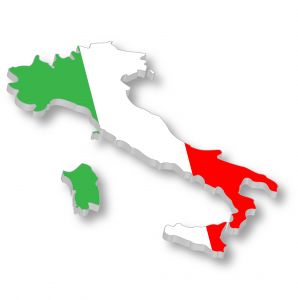
See map
|
| | |
| Our traditional Easter holiday led us to Sardinia this year. With April 1st being the official campground opening date, we flew down, fully loaded with great plans of leisurely coastal rides and camping at 20 degrees Celsius. Easy Jet from Basel to Cagliari was an easy, no frills, no stress option. |
| | |
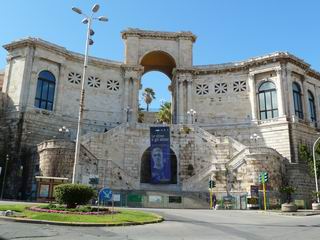
Bastione San Remy
| Cagliari, the main port town in the south, with a population of under 400.000 has a certain Spanish flair to it, reflecting 400 years of Spanish rule. The centre is fairly compact and can be easily explored in a day. |
| | |
 |
 |
Cagliari |
| | |
Leaving town on a beautiful cycle
path east bound along the pre-season beaches, was easy, but somewhat drab. We presume in summer, this looks a whole lot more happening. |
| | |
After about 30km, we hit a beautiful coastal road, while the famous Mistral
wind hit us! Record wind speeds of 55 knots (102 km/h) were recorded that very day, coming in gusts from the NW, leaving us at its total mercy. There were times when Darina was pinned to the railing hanging on for dear life, but we did live to tell the tale… |

You were warned!
|
| | |
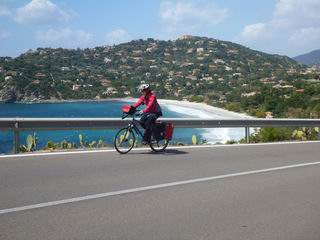
Beautiful coastal scenery |
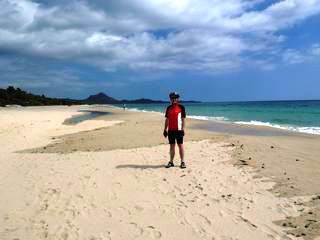
Costa Rei
|
| | |

Costa Rei ahead
|
| | |
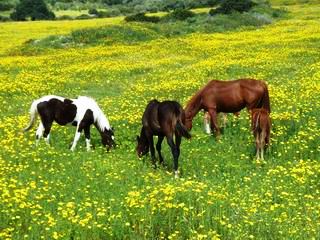 |

|
Buttercups and mimosa all the way! |
| | |
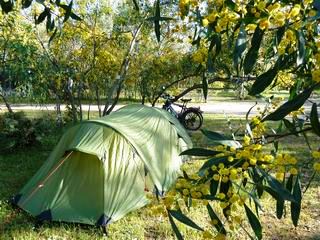
Villaputzu’s campground was open! | Chiuso was the name of the game on the east coast. Campgrounds, shops and towns had still not emerged from hibernation, even though temperatures were hovering around 20°C. B&Bs often came to our rescue. |
| |
The 60km stretch from Tortolí to Dorgali was one of our highlights. A couple of passes brought us up to 1017m, with spectacular panorama views of snow-capped ridges, the Mediterranean, grazing sheep and goats, pine forests and sheer cliffs.
The road itself is quite a feat of engineering. |
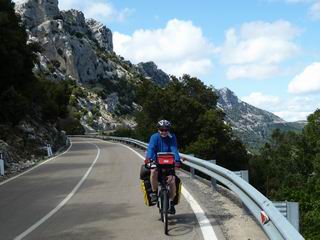
Orientale Sarda (Route 125)
|
| | |
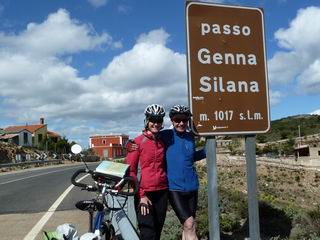
It’s all downhill from here, we hope! |
| | |
 |
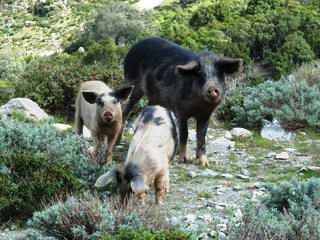 |
| |
| |

Route 125
|
| | |

Cala Gonone | Our second highlight was Cala Gonone, just 10km from Dorgali. This beautiful bay boasts numerous
secluded beaches with pink sand, lapped up by turquoise water to a backdrop of limestone and sandstone cliffs, a climbers’ paradise.
The Blue Marina limestone cave is accessible by boat and well worth the trip. |
| | |
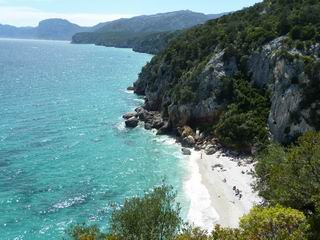
Caletta Fuili |
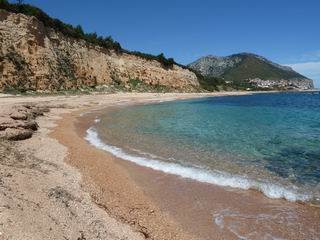
Cala Gonone |
| | |
| A typical breakfast in Sardinia consists of coffee, bread, jams/local honey and a variety of cakes (when you’re lucky!). |
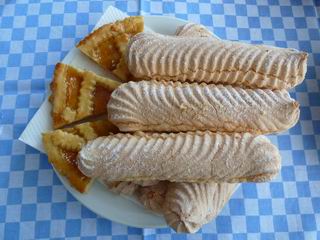
Breakfast goodies
|
| | |
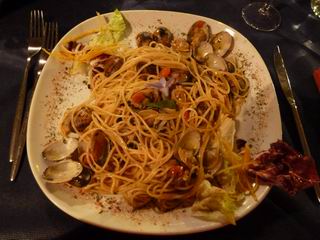
Spaghetti Vongole | Dinner, on the other hand, was a real treat with antipasti, pasta, seafood and the occasional mixed grill to satisfy any cyclist’s hunger splendidly.
|
| | |
With four sheep per head of population,
we were a tad disappointed that there wasn’t more lamb on the menus. We
did however enjoy the local pecorino sheep cheese. |

Where’s the lamb?
|
| | |
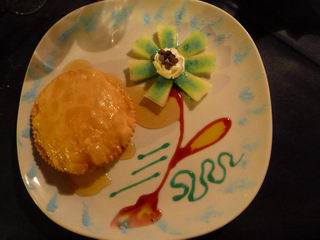
Dessert | Seadas are typical for dessert: deep-fat-fried pastries, filled with ricotta cheese,
and served
hot with local honey. |
| | |
Following local advice, we headed inland to experience the real Sardinia. Unfortunately, the weather
turned sour. The Mistral was back and we not only froze, but we also got wet! Again, some fabulous roads and great scenery dampened the blow.
|
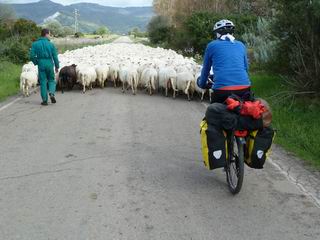
Kurt, the shepherd
|
| | |
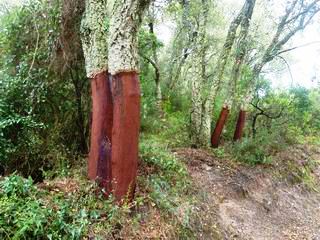
Cork trees |
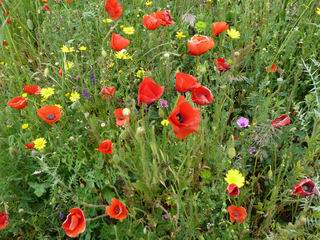
Spring is in the air!
|
| | |
 | During the early Bronze Age,
Sardinia was settled by the Nuragic people, who left behind all sorts of interesting stone ruins. Towers, burial grounds and settlements
are dotted around making for some interesting breaks from the saddle.
|
| | |
 |
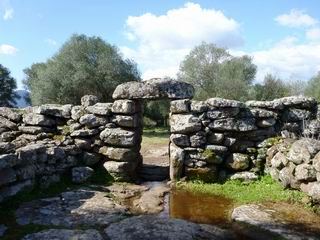 |
Settlement ruins from the early Bronze Age |
| | |
Orgosolo, famous for its bandits and outspoken locals, is now a showpiece of
murals criticising political systems, war, the police and anything else
that ruffles their feathers. |

Mural in Orgosolo
|
| | |
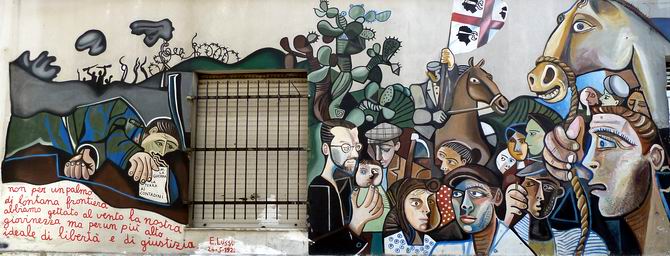
Orgosolo mural
|
| | |
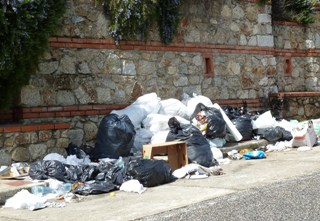
Welcome to Orgosolo! | Being one of the most-visited towns
in Sardinia, on account of these murals, it’s a shame that they haven’t managed to harness their energy into organising an effective
rubbish-collection system. The whole town is circled by sacks and sacks
of refuse dumped on the roadside. This is quite an issue all
around the island. |
| | |
Highlight number three was Bosa
on the west coast. What a colourful little treasure of a town, with a
great sense of aesthetics and pride. Built on a river with an arched,
stone bridge, overlooked by an imposing castle, Bosa is a real treat
after a few days of non-descript villages. |
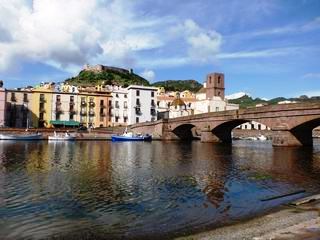
Bosa |
| |
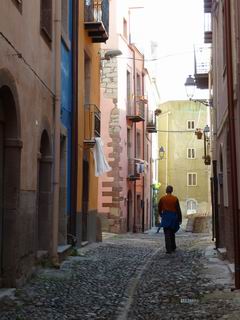 |
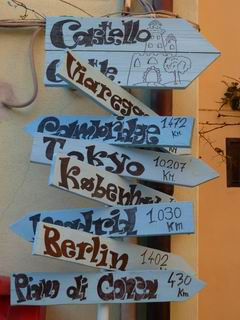
|
| | |
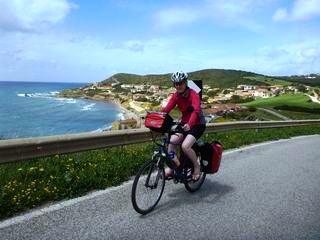
South bound | From here we headed south on the
west coast back towards Cagliari. On this coast, the mountains are
not as high, but that didn’t stop the engineers from bringing every road
up and down every hill possible! Although the cycling was strenuous, the
views were rewarding. |
| | |

There’s no shortage of holiday homes in Sardinia
|
| | |
 |
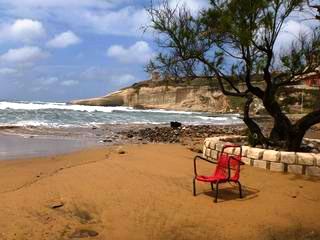 |
| |
| | |

Flamingos near Oristano
|
| | |
The Costa Verde boasts
the highest sand dunes in the Mediterranean and our explore afforded us the adventure of
two river crossings. |
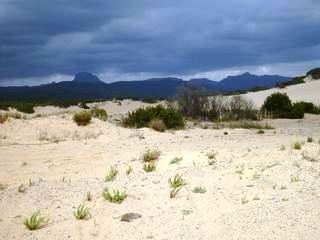
Costa Verde
|
| | |
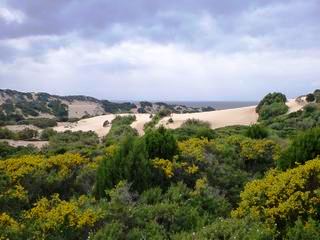 |
 |
On yer bike! |
| | |
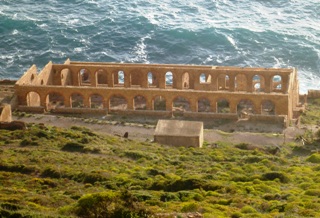
Store house ruin | The whole area is dotted with
reminders of Sardinia’s mining past in the form of colourful
ruins of old store houses, sifting factories and rusting machinery, as
well as beautifully restored office buildings and residences. The
history of mining in Sardinia predates Roman times, lead and silver
being the main minerals exploited. |
| | |

Deserted mine landscape
|
| | |

Director’s residence, Ingurtosu |
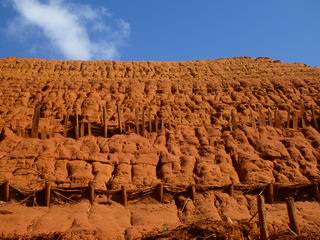
Slag hill
|
| | |
We still had a spectacular coastline down as far as
Nebida, where we turned inland and were blown all the way to
Cagliari. Cheers, Mistral! |
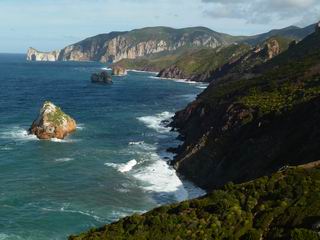
Nebida
|
| | |
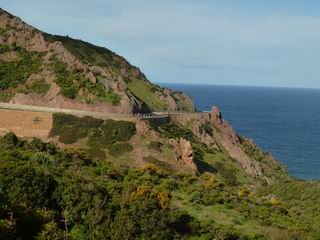 |
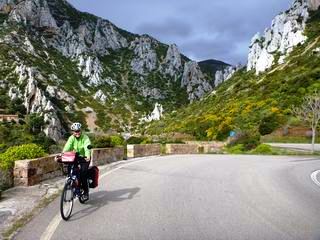
|
| Views from Nebida |
| | |

Pan di Zucchero, Nebida |
| | |
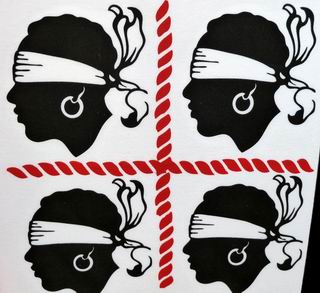
Sardinian flag | Sardinia is certainly a cyclists’ (and bikers’)
paradise. It has a great variety of landscapes, fabulous roads and
considerate drivers. With less wind and a few degrees more, we would even go back! On a more positive note, the Mistral was great training for our up-and-coming summer holiday. Watch this space! |
| | |
| |
| | |
